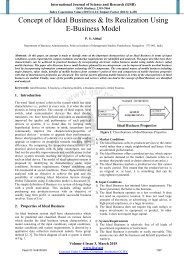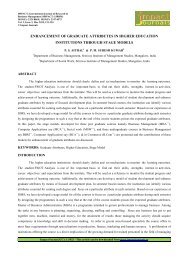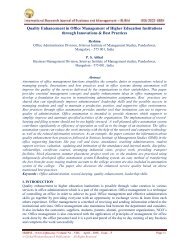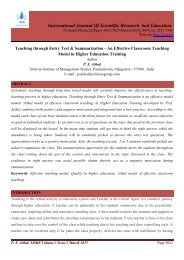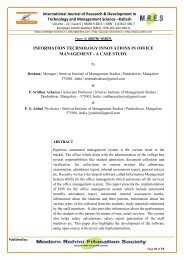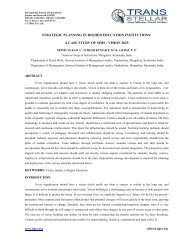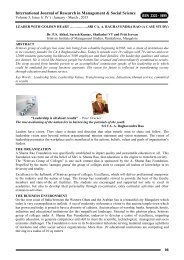How Innovations and Best Practices can Transform Higher Education Institutions : A case study of SIMS
Education has become competitive so as the educational institutions. In order to survive the competition, institutions have to improve the quality of their services. Changes in culture, aspiration and levels of skills required in securing employment for students, force higher education institutions today to rework on their educational models and add value to each and every aspect of their service. Innovations and best practices serve to enhance quality and add value. Srinivas Institute of Management Studies (SIMS), which combines technology, management and social service education has identified and implemented innovations and best practices to differentiate itself among the competitors and to add value in its educational services. In this paper, we have discussed innovations, small and big, develped indigineously and implemented during last four years. They are broadly classified under six key aspects namely "curricular aspects, teaching-learning and evaluation, research, consultancy and extension, infrastructure and learning resources, student support and progression, and governance, leadership, and management". The paper also contains some of the intitutional and individual faculty best practices having visible impact on the quality of higher education imparted by the institution. The best practices concern admission, fees, attendance, teaching, performance, skill building, employability, student involvement, collective learning, value addition, ensuring transparency, information dessimination etc. Finally two institutional best practices are elaborated with its aim of practice, underlying principles and concepts, particular contextual features or challenging issues that have had to be addressed in designing and implementing the practice, and its implementation, including its uniqueness in Indian higher education, evidence of success, identifying the problems encountered and resources required to implement the practice.
Education has become competitive so as the educational institutions. In order to survive the competition, institutions have to improve the quality of their services. Changes in culture, aspiration
and levels of skills required in securing employment for students, force higher education institutions
today to rework on their educational models and add value to each and every aspect of their service. Innovations and best practices serve to enhance quality and add value. Srinivas Institute of
Management Studies (SIMS), which combines technology, management and social service education
has identified and implemented innovations and best practices to differentiate itself among the competitors and to add value in its educational services. In this paper, we have discussed
innovations, small and big, develped indigineously and implemented during last four years. They are
broadly classified under six key aspects namely "curricular aspects, teaching-learning and evaluation, research, consultancy and extension, infrastructure and learning resources, student support and progression, and governance, leadership, and management". The paper also contains some of the
intitutional and individual faculty best practices having visible impact on the quality of higher education imparted by the institution. The best practices concern admission, fees, attendance, teaching, performance, skill building, employability, student involvement, collective learning, value
addition, ensuring transparency, information dessimination etc. Finally two institutional best practices are elaborated with its aim of practice, underlying principles and concepts, particular contextual features or challenging issues that have had to be addressed in designing and implementing the practice, and its implementation, including its uniqueness in Indian higher
education, evidence of success, identifying the problems encountered and resources required to implement the practice.
You also want an ePaper? Increase the reach of your titles
YUMPU automatically turns print PDFs into web optimized ePapers that Google loves.
International Journal <strong>of</strong> Management (IJM), ISSN 0976 – 6502(Print), ISSN 0976 - 6510(Online),<br />
Volume 6, Issue 2, February (2015), pp. 83-98 © IAEME<br />
IV.<br />
BEST PRACTICES AT <strong>SIMS</strong><br />
Time tested innovations are implemented in the form <strong>of</strong> best practices when they are worked<br />
out into a system which is durable <strong>and</strong> endurable [8-11]. Some <strong>of</strong> the best practices adopted <strong>and</strong><br />
implemented in <strong>SIMS</strong> are listed in TABLE 2.<br />
Table 2 : <strong>Best</strong> <strong>Practices</strong> at <strong>SIMS</strong><br />
1. Admission<br />
The first come first serve model <strong>of</strong> the institution provides equal opportunity for students irrespective <strong>of</strong> their caste,<br />
religion, nationality, gender <strong>and</strong> poor academic performance.<br />
2. Fees<br />
Admission to backward students on subsidized fee lower than University approved fee in selected courses helps the<br />
students from backward community to access their education.<br />
3. Attendance<br />
The Save a Year programme <strong>of</strong> the institute enables students with marginal attendance shortage to make up for the<br />
requirement by attending additional classes to avoid losing a year.<br />
4. Earnings<br />
The Earn while you Learn programme <strong>of</strong> the college encourages <strong>and</strong> provides opportunity to students to support<br />
themselves by taking part-time jobs along with studies.<br />
5. Teaching<br />
Entry test <strong>and</strong> summarization <strong>of</strong> the class is used as a teaching technique<br />
6. Performance<br />
The college conducts mentorship programmes to support students, faculty serve as mentors<br />
7. Employability<br />
A variety <strong>of</strong> certification programmes customized to suit the needs <strong>and</strong> requirements <strong>of</strong> students bridge the gap in<br />
curriculum based learning.<br />
8. Skill building<br />
Skill development programmes have been introduced to build job-specific skills.<br />
9. Improving pr<strong>of</strong>iciency<br />
Group/team projects for the students particularly in computer science increases their pr<strong>of</strong>iciency in developing<br />
various application s<strong>of</strong>tware.<br />
10. Motivation<br />
<strong>Best</strong> project <strong>of</strong> the year is awarded with prize annually, to encourage the quality <strong>of</strong> research projects by the<br />
students.<br />
11. Student Involvement<br />
Student developed s<strong>of</strong>tware is used for computerization <strong>of</strong> college library <strong>and</strong> related information system.<br />
12. Collective Learning<br />
Subscription <strong>of</strong> business newspapers <strong>and</strong> regular weekly news review in groups encourages collective learning<br />
13. Developing Service Mindedness<br />
The institution encourages social service programmes involving students through its NGO.<br />
14. Learning<br />
Teaching Plan <strong>and</strong> <strong>study</strong> materials are prepared according to the syllabus with chapter end assignments in all<br />
courses <strong>and</strong> subjects.<br />
15. Value addition<br />
Apart from imparting learning through University curriculum, workshops, conferences, seminars, symposia etc. are<br />
conducted to provide value-addition.<br />
16. Extended facility<br />
Library <strong>and</strong> computer facility are kept open for extended hours till late evenings <strong>and</strong> holidays.<br />
17. Feedback<br />
Student feedback is treated as a valuable output <strong>and</strong> is collected through a variety <strong>of</strong> ways such as feedback form,<br />
suggestion box, open door policy etc.<br />
18. Monitoring<br />
Comprehensive performance management system for self evaluation <strong>and</strong> rating <strong>of</strong> faculty by students.<br />
19. Ensuring Transparency<br />
Faculty members are involved in admission process. Internal assessment <strong>of</strong> students is based on explicit criteria.<br />
87




